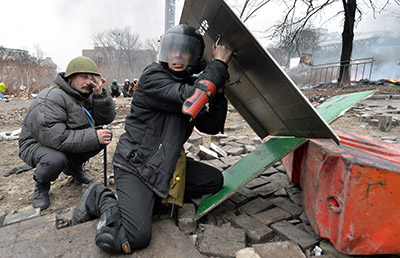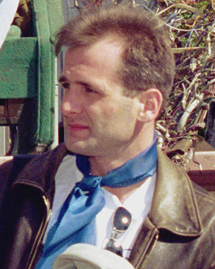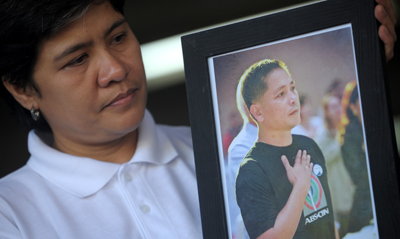Slideshow: Journalists killed in 2014
In 2014, at least 60 journalists and 11 media workers were killed in relation to their work, according to CPJ research. Local and international journalists died covering conflicts, including in Syria, Iraq, and Ukraine, while many others were murdered reporting on corruption and organized crime in their own countries. Here, CPJ remembers some of the…
Press in Ukraine still suffering one year after attacks on journalists
A year ago today, the Committee to Protect Journalists reported on the first mass assaults on press freedom in Ukraine, after police were ordered to disperse protesters in the capital, Kiev, and other cities. At least 51 journalists–including local and international reporters–were attacked by police and protesters while covering the early days of the standoff…
Mission Journal: Attacks on journalists in Ukraine lead to information vacuum
“There are no [independent] Ukrainian journalists left in Donetsk,” said Aleksei Matsuka, chief editor of the regional news website Novosti Donbassa (News of Donbass). “They have fled the region since pro-Russia separatists started targeting and kidnapping reporters,” Matsuka told CPJ during our brief meeting in Kiev.
In Ukraine, some updates on this week’s abducted and missing journalist(s)
On Wednesday, we reported that in Ukraine this week, at least two journalists had gone missing, while pro-Russia separatists abducted a fixer and briefly detained a reporter. Also, the self-declared Donetsk People’s Republic said it was banning journalists from the conflict area. We noted that press freedom violations “are happening at dizzying speed in eastern…
Slideshow: Covering protests in Ukraine
Coverage of street demonstrations is an exceptionally dangerous assignment, with journalists subject to assaults, obstruction, detention, raids, threats, censorship orders, and confiscation or destruction of equipment. This report is one in a series of three by Getty photographers who documented for CPJ their recent experiences covering protests and shared their photographs.
Slideshow: Covering protests in Crimea
Coverage of street demonstrations is an exceptionally dangerous assignment, with journalists subject to assaults, obstruction, detention, raids, threats, censorship orders, and confiscation or destruction of equipment. This report is one in a series of three by Getty photographers who documented for CPJ their recent experiences covering protests and shared their photographs.

Body armor must match threat in Venezuela and Ukraine
Covering street violence is one thing. Covering gunfire is another. This week, firearms were unexpectedly introduced into ongoing clashes between protesters and police in two parts of the world, raising the threat level faced by journalists trying to cover events.

Finding common cause from first online journalist murder
The first online journalist killed for his work disappeared one night 12 years ago in the Ukraine. Georgy Gongadze, 31, left a colleague’s house to return home to his wife and two young children. He never arrived. Seven weeks later, a farmer, a few hours’ drive away, discovered the journalist’s headless corpse. Gongadze edited the website Ukrainska…

